#WritingBasics
Text
World-Building Tools and Resources List
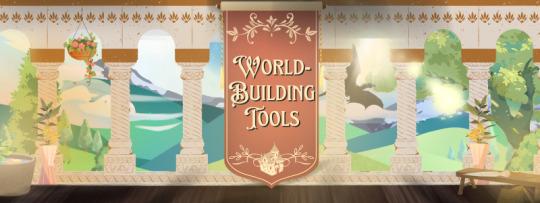
If a link has a ⭐ beside it, it means that it is a resource that I personally use regularly, or have used in the past. Most often, this will be links to programs or other like resources.
If a link has a 💖 next to it, that means that I really like the content of the link. Most often, this will be for links to media, such as videos.
Please note that I have not tried everything on this list.
APPS AND PROGRAMS
⭐Fantasia Archive (Free)
Tennessine Flag Maker (Free)
Fantasy Calendar (Free limited version, subscription full version)
Bubisco (Free limited version, paid full version)
Campfire (Free limited version, subscription full version)
World Anvil (Free limited version, subscription full version)
Legend Keeper (Free trial, subscription full version)
One Stop for Writers (Free trial, subscription full version)
Inkarnate (Free limited version, subscription full version) - suggested by @trager-bombs
WORLD BUILDING QUESTIONS
Reedsy
Ellen Brock Editing
SFWA
GENERATORS:
World Maps:
Donjon’s Fantasy Map Generator
Mewo2’s Fantasy Map Generator
💖Azgaar’s Fantasy Map Generator
City/Village Maps:
💖Watabou’s City Map Generator
💖Watabou’s Village Generator
Eigengrau’s Town Generator
💖Probabletrain’s Modern City Map Generator
Street/Neighborhood Maps:
💖Watabou’s Neighborhood Generator
Location Details Generator:
Rangen’s Country Generator
Rangen’s City Generator
Donjon’s Fantasy Calendar Generator
Rangen’s Laws Generator
Springhole’s Random Holiday Generator
Springhole’s Landmarks Generator
Arkimedz’s Star Map Generator
Donjon’s Demographic Generator
Springhole’s Plant Generator
Languages:
Vulgar Language Generator
Madequa’s Glyph Generator
Money:
RanGen Currency Generator
Springhole Currency Generator
MAP MAKING
Cartographers Guild (Map Tutorials)
⭐Wonderdraft (Map Maker. Paid )
MISC
Dan Koboldt (a blog about getting the science right in Fantasy and Sci-Fi)
💖Food Timeline (shows what what people ate in history)
💖Orbis: helps estimate travel time based on distance and travel type
YOUTUBE
Ask a Mortician: Has videos about historical death customs
English Heritage: The Victorian Way: A series all about Victorian life
💖Modern History TV: Medieval Life
Tasting History: Historical Recipes
Hands on History: Viking history mixed with advertisements for their tours
Grimfrost: Viking history mixed with product advertisements
The Welsh Viking: Viking history
The British Museum: History told through artifacts
#worldbuilding#world building#fantasy world#fantasy worldbuilding#writing#write#writer#author#writing fantasy#fantasy writer#WritingBasics#WorldbuildingOther
615 notes
·
View notes
Text
Grant Writing 101: A Beginner's Guide
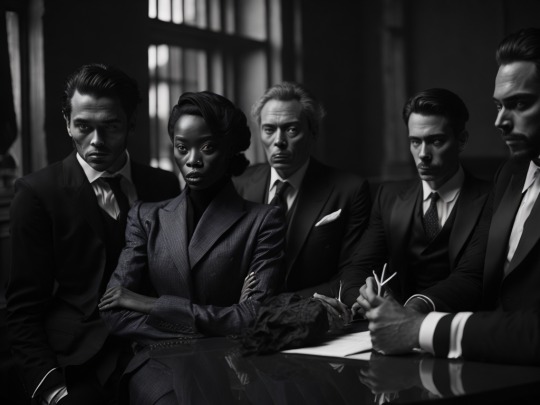
Hey there, aspiring grant writers! Ever wondered how to turn your project dreams into funded realities? Get ready to embark on a journey to master the art of grant writing – from finding the perfect opportunities to crafting proposals that truly stand out. Let's dive in and unravel the secrets to securing those coveted grants!
Outline
- Introduction
- What is grant writing?
- Importance and benefits of learning grant writing.
- Overview of the main steps and challenges in grant writing.
- Finding Grants
- Researching potential grant sources.
- Types of grant opportunities.
- Using online databases, websites, newsletters, and networks.
- Examples of different grants and their requirements.
- Grant Writing Basics
- Planning a grant proposal.
- Guidelines and instructions.
- Crafting a clear problem statement.
- Defining project goals, objectives, design, methods, evaluation, and sustainability.
- Building an effective project budget and timeline.
- Writing Grants Effectively
- Tips for a concise and persuasive proposal.
- Examples of successful grant proposals.
- Common mistakes to avoid.
- Winning Grants
- Submitting and following up on a grant proposal.
- Meeting deadlines and procedures.
- Building relationships with grant makers.
- Handling feedback, revisions, and negotiations.
- Accepting a grant award gracefully.
- Conclusion
- Summarizing key points.
- Encouraging readers to apply what they learned.
- Providing a call to action.
- Additional resources for further learning.
How to Master the Art of Grant Writing: A Beginner's Guide to Finding, Writing, and Winning Grants
Grant writing is a skill that opens doors to opportunities for organizations and individuals alike. It's not just about securing funding; it's about effectively communicating your vision and mission to potential supporters. In this beginner's guide, we will delve into the intricacies of grant writing, covering everything from finding suitable opportunities to writing compelling proposals and ultimately winning grants.
Introduction
Grant writing is a specialized form of writing focused on securing funding from various sources such as government agencies, foundations, and corporations. The ability to write effective grant proposals is a valuable skill for anyone involved in nonprofit work, community development, or research. Learning how to master this art can make a significant impact on your ability to bring your projects to life.
Understanding the importance and benefits of grant writing is crucial for beginners. Grants provide the financial support needed to implement projects and initiatives, making a positive difference in communities and organizations. This guide aims to demystify the grant writing process, breaking it down into manageable steps for newcomers.
Finding Grants
Researching Potential Grant Sources
The first step in mastering grant writing is identifying suitable opportunities. This involves researching potential grant sources, including government agencies, private foundations, and corporate philanthropy programs. Knowing where to look is key, and we'll explore the various avenues available, including online databases, websites, newsletters, and professional networks.
Types of Grant Opportunities
Grant opportunities come in various forms, each with its specific requirements and expectations. Understanding the types of grants available—from project-specific grants to general operating grants—will help you narrow down your focus and tailor your proposals accordingly. We'll explore examples of different grants and discuss their unique characteristics.
Grant Writing Basics
Planning a Grant Proposal
Before putting pen to paper, it's essential to plan your grant proposal meticulously. We'll guide you through the process of understanding and following the guidelines and instructions provided by the grant maker. This includes defining a clear problem statement, establishing project goals and objectives, designing effective project methods, and ensuring sustainability.
Crafting a Persuasive Proposal
Writing a grant proposal involves more than just presenting facts. We'll provide tips on crafting a persuasive proposal that clearly communicates your project's value and impact. Examples of successful grant proposals will illustrate effective writing techniques, while insights into common mistakes will help you avoid pitfalls.
Writing Grants Effectively
Tips for a Concise and Persuasive Proposal
In this section, we'll delve deeper into the specifics of writing an effective grant proposal. From creating a compelling narrative to addressing the evaluation criteria, we'll share practical tips to ensure your proposal stands out. Remember, clarity and conciseness are key when conveying your ideas to grant makers.
Examples of Successful Grant Proposals
Learning from real-world examples is a powerful way to understand what works. We'll showcase successful grant proposals that secured funding, breaking down the elements that contributed to their success. Analyzing these examples will provide valuable insights into the expectations of grant makers.
Winning Grants
Submitting and Following Up
Submitting a grant proposal is only the beginning. We'll guide you through the post-submission process, including how to follow up with grant makers. Meeting deadlines and adhering to procedures are crucial steps toward increasing your chances of success.
Building Relationships with Grant Makers
Building a positive relationship with grant makers goes beyond the proposal stage. We'll discuss strategies for effective communication, handling feedback and revisions, and navigating negotiations. Establishing rapport with grant makers can lead to long-term partnerships.
Accepting a Grant Award Gracefully
Congratulations, you've won a grant! Now what? We'll provide guidance on the proper etiquette for accepting a grant award, ensuring a smooth transition from proposal acceptance to project implementation.
Conclusion
In conclusion, mastering the art of grant writing is a valuable skill that can open doors to funding opportunities and bring your projects to life. This guide has covered the essentials, from finding grants to writing persuasive proposals and winning awards. Now, it's time to put your newfound knowledge into action. Remember, grant writing is a learning process, and each proposal is a chance to refine your skills.
Call to Action: Apply what you've learned and start writing your own grant proposals. The more you practice, the more confident and proficient you'll become in the art of grant writing.
Faq
What is Creative Writing Class?
A creative writing class is an educational setting that fosters artistic writing, exploring fiction, poetry, and non-fiction. It goes beyond grammar, encouraging self-discovery and unique voice development. Expect interactive activities, discussions, and constructive feedback.
What is a Creative Writing Class Like?
A creative writing class is an immersive experience combining theory and practice. It delves into storytelling techniques, creating a supportive community for students to share ideas, receive critiques, and refine their skills through various activities and workshops.
What Do You Do in a Creative Writing Class?
In a creative writing class, participants engage in activities like writing exercises, brainstorming, group discussions, and workshops. Emphasis is on creativity, exploration of genres, sharing work, and providing constructive feedback for continuous improvement.
Where Can I Take a Creative Writing Class?
Creative writing classes are widely available at universities, community colleges, and online platforms like Coursera and Skillshare. Local community centers, libraries, and universities also host workshops, providing accessibility to learners of all levels.
What Do You Do in Creative Writing Class?
In a creative writing class, immerse yourself in storytelling through writing, sharing, and engaging in discussions. Explore different writing styles, experiment with techniques, and receive guidance to express yourself creatively, whether through short stories, poems, or personal essays.
Read the full article
#BeginnersGuide#FundingSkills#GrantOpportunities#GrantWriting#GrantWriting101#GrantWritingClasses#WritingBasics
0 notes
Text
The Chalaang- Your Digital Marketing Virtual Assistant |
The Chalaang- Your Digital Marketing Virtual Assistant
1.3 K VIEWS
Register For Our Online Courses
Select Course—Advanced PhotographyMakeupRadio JockeyAdvanced DJContent WritingBasic Graphic DesignStock MarketReal Estate BrokerE-SportsBasic DJBasic PhotographyAdvanced Graphic DesignPodcastSoftskills
Language Of…
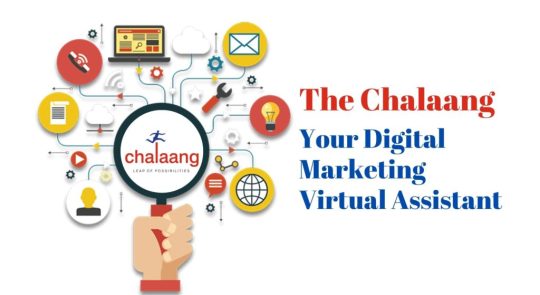
View On WordPress
0 notes
Photo

I have had many instances in my life which made my senses go numb. After a few years when I look back, I find it foolish that I spent so much of my practice time in the dark corners without benefiting my life. I could have done a lot then for this present time but my judgments were wrong and my mind lied to me that it was the end of everything. However, I am happy that I reclaimed my happiness denying my depression and I am what I am today. If you have some moments that you feel that you seriously need someone to talk about. Let me be the ear. Let's face it and overcome it. I write motivational stories that will definitely help you to find a way. Also you can follow me @_boomerangmoments_ Or just click the 🔗 link in the bio to read some motivational blog post. Let's connect. #wordsheal #wordgasms #blogwriting #blogwriter #storyblogger #lifestyleblogger #lifestyleguide #wordsoftheday #baldisbasicsineducationandlearning #writingbasics #whatyouneedtoknow #thursdayfeels #thursdaytruth #thursdays #thursdaythoughts #authorpreneur #authoursofinstagram #indianbloggers #thursdaynight https://www.instagram.com/p/CCd-KPvgwV4/?igshid=1t3z0z31lbpct
#wordsheal#wordgasms#blogwriting#blogwriter#storyblogger#lifestyleblogger#lifestyleguide#wordsoftheday#baldisbasicsineducationandlearning#writingbasics#whatyouneedtoknow#thursdayfeels#thursdaytruth#thursdays#thursdaythoughts#authorpreneur#authoursofinstagram#indianbloggers#thursdaynight
0 notes
Text

Let’s just get one thing straight right away: self-care is important for everyone. Not only do modern Americans (and anywhere else with a similar work week) work more than the average medieval peasant did, but stress is on the rise worldwide.
Stress is designed to give humans a short burst of energy and alertness, but it can also damage our bodies. It can cause sickness, increase chances of a heart attack, increases your appetite, and stress even causes way more than that. More info on stress on the body here.
So, yes, stress is bad for absolutely everyone, however, it is particularly hard on creatives. Yes, the bodily damage stress causes is the same as on every other person, but it is the harm to our work that is affected the most.
Studies show that the higher the stress, the lower the creativity, so your stress could be seriously limiting the quality of work you are putting out.
Don’t know where to start with self-care? I created a list of some ideas, and added plenty of links for people wanting to read more.
Take part in self-care Sunday. Some people need to schedule in a self-care day or they won’t do it. They put it off and put it off, so that it never happens. That’s why a growing number of people have started doing “self-care Sundays.” Simply put, it is one day during the week that is all about prioritizing your health.
Take a tea break. Tea has been noted to lower stress, so go sit in a comfortable spot with your favourite tea, and put your feet up for a while.
Take a phone/internet break. Phones are great in the way that they can give us constant stimulation, but is that a good thing? Not only is there a link between social media and depression, but phones can actually lower your creativity. It is when people are bored that their minds tend to wander and come up with great ideas, but how does that happen now with smartphones? Try a 24h internet detox, and see how you feel the next day. If you feel at all better, then maybe schedule a few days a month that you spend some time away from the digital world.
Go sit in nature. If it is possible for you and the weather is nice, go sit in nature. Not only is it great for stress levels and creativity, but it can even leave you feeling more rested. In japan, they even have a word for this magical effect nature has: shinrin-yoku, or “forest bathing.”
Workout. I know, I know, some of you are cringing at that, but it really is important. Not only does exercise help with your health and lower stress, but it does also boost creativity. If you are new to working out, start small! Aim for 10 min a day, and do not be afraid to “cheat” (example: modified/kneeling pushups) until you build your strength up.
Go For A Walk. Walking outside is shown to dramatically reduce stress, and boost creativity.
Meditate. This one is hard, but studies do show that meditation dramatically lowers stress, keeps your brain young, and, you guessed it, boosts creativity.
Take a Nap. That’s right, nap time for adults. Did you know some medieval serfs had a scheduled nap time too? When people get the “3PM slump” a nap might really be in order. Studies show it lowers stress and boosts creativity. Do note that the keyword here is “nap.” Do not nap more than 30 min or you will go into too deep of a sleep, making you groggy and potentially mess with your sleep cycle. Instead, aim for 10-30 min.
Play with your pet. Yep, pets lower stress.
Eat Well. Yes, your body does crave carbs and fats when you are stressed, but a balanced diet can help your body manage stress levels, and boost creativity.
Take a Bath. Do I really have to link for this one? I doubt it. Yup, having a bath lowers stress.
Get proper sleep. Not getting enough sleep at night is horrible for your body, creativity, and your stress levels. Link here.
Join a group. For example, a writing group. Not only is chatting good for your mental health, but it can be helpful to chat with creatives who are going through the exact same things you are. Just be sure it is a positive environment.
Listen to happy music. Studies show it can help.
If those are not enough, since the first day of fall is coming up (northern hemisphere) here are some fall-themed ideas. Pick one at random, and enjoy!
🌻 Find some sunflowers to admire
🔥 Have a fire with warm blankets (if its cold) and snacks
🥧 Bake recipe with fall ingredients (like apples or pumpkin)
🥣 Cook some chili
☕ Brew up some hot apple cider
☕ Get a pumpkin themed drink from somewhere
🍏 Pick some apples
🍏 Dip apples in caramel
🥕 Visit a farmers market
🌽 Visit a corn maze or bale maze
🕯 Spend a day antiquing
📖 Read a book with a warm drink and a fall candle
🍂 Decorate for fall
🍂 Read a book outside
🍂 Have a fall picnic
🍂 Go for a fall drive or hike
🍂 Go view some fall leaves
🍂 Watch geese flying south
🎃 Decorate for Halloween
🎃 Listen to a spooky audiobook or podcast
🎃 Read a spooky book
🎃 Visit a pumpkin patch
🎃 Carve or paint a pumpkin
🎃Go on a ghost tour
🎃Take a graveyard tour
🎃 Cozy up with some special snacks and watch a Halloween movie or show; such as Over The Garden Wall.
#how to write#writers#writers on tumblr#writing tip#writing help#writing tips#writing advice#fantasy writer#writing fantasy#write#writer#writing#writers of tumblr#writeblr#writingbasics#productivity
72 notes
·
View notes
Text
How to Write Like a Ghibli Movie
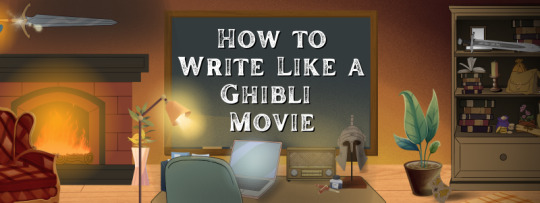
One thing Ghibli is amazing at is romanticizing daily life. They make even the most mundane tasks somehow seem beautiful, and while not all aspects of that style will fit in every type of genre, I believe there is still much to learn from the details these movies showcase.

Lingering on Scenery
Many movies quickly pan across the scenery simply to set the scene, then jump right in on what the character is doing in that space. Ghibli movies instead take longer to pause on the scenery, giving viewers a little longer to admire the landscape.

During calm moments, they linger on something as simple as a droplet sliding off a blade of grass, or the way the light dances on water. It is an attention to detail more commonly found in nature documentaries, and yet Ghibli brings it into nearly any story they are telling.
Ghibli uses the slow moments of stories to remind you that immersing yourself in the scenery is an integral part in getting to know the world. They could show a simple field of grass, but instead show grass speckled with wildflowers, rocks, and fanning butterflies.

Funnily enough, this is something commonly advised against in most writing advice. “People like fast stories now,” they say, but by slowing down the camera, you can really show that the main character is simply a small part of a world that is continuously moving and changing around them.
Finding the proper balance between enough detail to set the scene without going overboard and boring the readers is one aspect of writing I am still working on as well.
The Lesson: Take time to describe the details of the world so that your readers can have a chance to feel it is real, and bigger than just around your character.

Setting the Mood
Ghibli is amazing at using scenery to set the mood. When Chihiro is running from No-Face in Spirited Away, the scenes are filled with items, people, and a cluster of vivid details. They could have had the halls empty, but filling them adds to the tension.
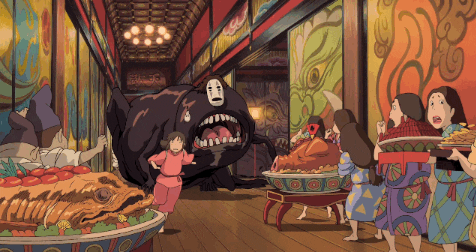
In Nausicaa of the Valley of the Wind, Nausicaa is amazed by the natural world, and they show that as she traverses a forest with child-like wonder instead of fear. They cement this idea when spores start falling, and it looks like snow.
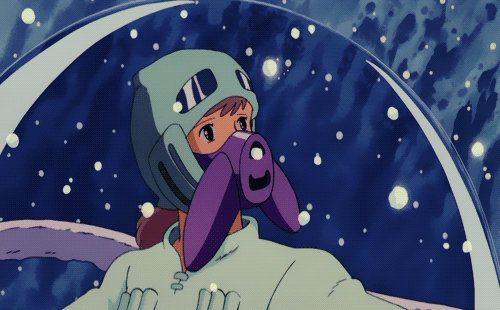
The Lesson: Landscape and the colors and weather within it can be used to enhance the mood and characterization in your stories.

Sensory Details
If Ghibli wrote books, they would never write “she was frying an egg.” Instead, Ghibli would explain that the egg popped as it danced across the hot oil. It would compare the colour of the yoke to something beautiful, and mention texture and taste as the character takes a bite.
This attention to detail is what makes the food in Ghibli look so appetizing. They engage your senses using sound and vision to make you feel like you are part of their world.
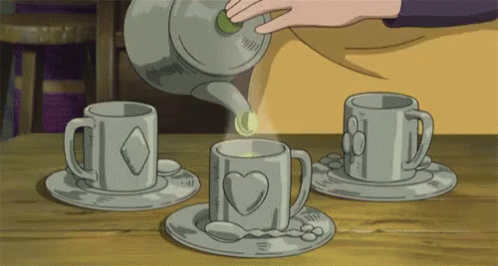
In The Secret World of Arrietty, this character is doll-sized. Notice how the tea looks different at such a small size . Instead of tea pouring out, it falls out a single droplet, and fills the mug.
It is how the bamboo ladder creaks while the main character climbs it, it is how quiet the scenery gets when something scary is about to happen, or how slick a surface is in the rain.
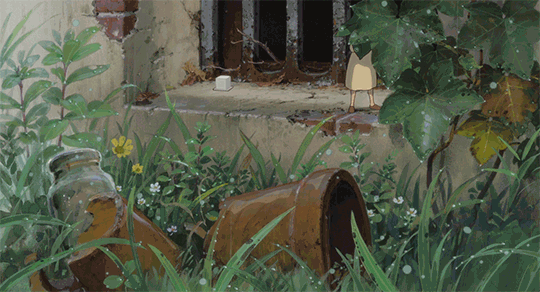
They could have skipped to Arrietty simply running, but instead she flicks off the droplets on the leaf, and her foot slips on the pot slightly.
In writing, you have even more sensory details to work with than a Ghibli movie has, because while they can mostly only rely on sight and sound, you have the added benefit of being able to describe all the other senses as well.
If you are showing off a world different from our own, these details can help readers settle into it.
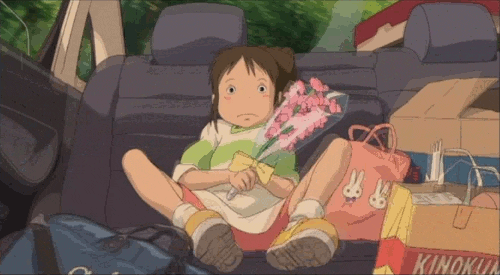
In this scene, all of the items bouncing (including the ones almost coming out of the bag) adds to the fear she is feeling.
Chihiro slips on mud while trying to fill a tub, she reacts to the horrible smell of a guest, and as she falls through the sky, the camera lets you see how the tears roll up her face instead of down. All this makes her feel more human, and helps us connect to her, the scene, and the world, more.
The Lesson: Using sensory moments can add emotion to the scene, and also add to the realism of your world-building. Instead of just showing the readers the world, you are hinting at what it is like to be in that world.

Trusting Viewers
Hollywood movies often flat out has characters point things out to the people watching. Ghibli, on the other hand, does not do that. Instead of telling people how things are, Ghibli let’s the viewers come up with their own interpretations, while also not pointing out the small details.
For example, I have seen Princess Mononoke several times, but — until someone recently pointed it out — I never noticed that at the end when the people are in the lake, the people with leprosy had been healed by the deer god. They are characters in the background, but have their own story.
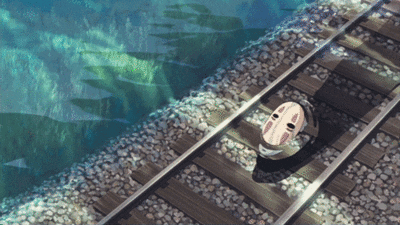
The main plot of Spirited Away was Chihiro saving her parents and getting home, but very little was explained about the world or spirits living there. This added to the mysterious and magical feeling.
For an example in interpretation: Kiki‘s Delivery Service is about a girl struggling to learn how to make her way in the world, but many Ghibli fans say that the true story is about burnout and the importance of self-care to keep your spirits up.
The Lesson: Your plot should be clear to keep from confusing your viewers, but your story can have a deeper meaning or hidden details for the readers to find.

That’s it for now! Did I miss anything that you think is an important aspect of Ghibli? If so, please let me know! I would love to learn more.
#writing#write#ghibli#ghibli films#studio ghibli#writer#writing fantasy#fantasy writer#Worldbuilding#world building#writingbasics
73 notes
·
View notes
Text
Free Writing Programs 📝📖

A while back I did a post about resources for world building, but this time I wanted to chat about writing programs.
For this list, I am focusing only on free programs. I understand there are many great paid programs, but I think the free programs often don't get as much attention, and people who need them might not know they are an option.

Author Specific:
yWriter: I used to use before I got Scrivener. It is not the most sleek looking program, but it works.
Manuskript: I haven't tried this one, but it looks similar to yWriter, but with some different features
Bibisco: I haven't tried this one
SmartEdit: a MSWord alternative for writers that is supposed to have several helpful editing features. I haven't tried it yet.
Wavemaker: While not open-source, this program is free and can sync to the cloud. I haven't tried it yet.
Quoll Writer: I haven't tried it yet. This is open-source, and has several unique features, such as "warm up session."
Reedsy Book Editor: It is in website only, but formats your book
(Added to the list by alinearesque)
Not Author Specific
Obsidian: I have started using this for worldbuilding, but many authors use it for writing. Within it, you can create your own wiki, and view connections in a cool graph. It is open source, and has many plug-ins you can add.
Only Office: This one is good for people who want a private cloud-hosted alternative to Google Docs. It is open-source.
Joplin. I haven't tried this one. The program is free, but the cloud hosting does cost money.
Trillium: I haven't tried this one, but it is self-hosted and open-source.
Anytype: I haven't tried this one. The program is free and private, but for the cloud, you have 1GB of storage, then you'll need a plan for more.
27 notes
·
View notes
Text
A Big List of Fantasy Subgenres
I decided to make a list of just some of the subgenres out there. You may notice some do overlap, but they are all terms people search for, so if your story falls under more than one, remember to use it as a search term/tag for it.
You’ll notes that I did add a few sci-fi related ones, just in case someone is writing a blend.
A 🔒 means tread carefully or you may face criticism.
Plot-Related Fantasy Subgenres
Magical Realism: The real world but with hints of magic or fantasy
Sword and Sorcery: sword-wielding heroes on violent adventures involving magic.
Dark Fantasy: Fantasy that does not shy away from violence and horror. It often has a gloomy tone.
Grimdark Fantasy: An even darker sibling of dark fantasy. This may include dystopian settings, amoral characters, and great violence.
Mythic Fantasy: Fantasy inspired my myth, legend, folklore, or fairytales.
Arthurian Fantasy: Retellings of (or stories based on) Arthurian legends.
Fairytale Fantasy: fantasy stories that are inspired by or retellings of fairytales
Anthropomorphic Fantasy: Humanized (even if just in intelligence) animals as the main protagonists in a fantasy story. Examples: Watership Down, Redwall, Silverwing
Coming-Of-Age Fantasy: These stories tend to focus on self-development and the transition into adulthood
Portal Fantasy/Crossworlds Fantasy/isekai): The main character (often from a modern world) finds themselves in a fantasy world. Example: The Lion, The Witch, and the Wardrobe
Historical Fantasy: A specific real-world historical setting, but with fantasy.
Sci-fi Fantasy: Fantasy blended with scifi. Imagine magic users on spaceships.
Paranormal Fantasy: Fantasy involving the paranormal
Quest Fantasy: fantasy that involves setting out to fufil a quest. Example: The Hobbit
Heroic Fantasy: A setting with magic, no modern technology, and less high-stakes than dark fantasy. Any problems can likely be fixed with a quest. Example: Jack the Giant Killer
Assassin Fantasy: Fantasy that focuses on assassins
Military Fantasy: Fantasy that focuses on people in the military, and often includes the politics that come with it
Political Fantasy: A focus on political drama in a fantasy world. Example: Game of Thrones
Hard Fantasy: A world of hard-set rules on how the world works. Magic has rules, and how it fits in the world is obvious
Soft Fantasy: Less rules, less explaining on how things work. The magic can seem dreamlike, with barely or any explanation on how it works or why.
Heist Fantasy: Fantasy, but a group of people trying to steal something. Examples: Six of Crows, The Lies of Locke Lamora
Comic Fantasy/Comedy Fantasy: Fantasy, but the main goal is humor
Cozy Fantasy: A fantasy setting, but with low-stakes, a happy ending, and no gratuitous violence. Example: Legends & Lattes
Romantic Fantasy: A story with fantasy elements, but the main focus is romance
Setting Sub Genres
High Fantasy: fantasy with a make-believe world
Low Fantasy: Set in a familiar real-world setting
Gaslamp Fantasy: typically set in an heavily Victorian or Edwardian inspired setting(ie, lit by gaslight). This is not to be confused with Steampunk, which has more advanced technology.
Tech Noir: A blend of film noir and sci-fi. Also Called: Cyber Noir, Future Noir
Alternate History: History, but with a “what if” added.
Flintlock Fantasy: fantasy, but influenced by the early industrial revolution, so gunpowder is more commonly available
Medieval Fantasy: A fantasy set in or inspired by the medieval era. Examples: Robin Hood, The Sword in the Stone
Urban Fantasy: A fantasy set in a more modern era. Examples: Buffy the Vampire Slayer(TV)
Weird West: fantasy or scifi in a western setting. This subgenre has been around since 193
Western Fantasy: Old west, but fantasy.
Pirate Fantasy/Swashbuckling: Pirates, but fantasy.
🔒 Wuxia: Chinese martial arts with a fantasy twist. Example: Crouching Tiger Hidden Dragon
﹌﹌﹌﹌﹌﹌﹌﹌
Punk Subgenres
RETRO/VINTAGE INSPIRED
Steampunk: Inspired by the Victorian to Edwardian era fashion with steam-powered machinery.
Clockpunk: child of steampunk with a lot more clockwork machines.
Dreadpunk: Gothic horror/fantasy based in the Victorian era. Examples:Dracula, Frankenstein, Bloodborne
Cattlepunk: Advanced tech meets old west. Think steampunk, but cowboy.
Dieselpunk: Based on around the end of WW2-1950’s, with diesel engines instead of steam and a gritty feel. Example: Bioshock
Decopunk/Coal Punk: the child of dieselpunk, but less gritty and more shiney.
Formicapunk/Cassette Futurism: Advanced tech, but in the 1960’s-90’s.
Raypunk: retro futurism. Rayguns, flying cars, all with vibrant retro colours. Example: The Jetsons(cartoon)
Atompunk. The dark sibling of raypunk.
Stonepunk: a stone-age inspired life, but modernized. Example: The Flintstones
FUTURISTIC
Cyberpunk: a dystopian futuristic setting where all the tech creates a depressing feel. Often has advanced tech, dugs, an oppressive government, and crime lords. Example: Blade Runner(movie), Psycho-Pass(Anime)
Post-Cyberpunk: the child of cyberpunk, but less bleak.
Biopunk: Like cyberpunk, but with a focus on biotechnology. Biohackers, biotech megacorporations, opressive government.
Solarpunk: An optimistic view of the future that focuses on living with nature, green energy, multiculturalism, and an anti-capitalist theme.
Lunarpunk: the sibling of solarpunk, but with a lot more futuristic elements (such as glowing fabrics) and more of a nod to witchcraft
Tidalpunk: Solarpunk, but at sea
Nanopunk: nanites/nanobots/nanotechnology server the main source for the tech of this society
OTHER:
Mythpunk: Stories that draw heavily from myths, folklore, and fairytales, often in a real-world setting. Examples: Pan’s Labytinth, Over The Garden Wall, Sandman
Elfpunk: Inspired by either Tolkien-style, or folklore inspired elves or fae with a dark, gritty, and sometimes unexpected setting.
Aetherpunk/Magicpunk: Magic and technology blended. Example: Arcane(Netflix TV)
Dungeonpunk: The more dark and gritty sibling of aetherpunk, often with more typical fantasy elements(swords, wizards, so on).
Desertpunk: A harsh desert environment with warring groups of people. Example: Mad Max
Oceanpunk: Set in a watery world where ships are pretty well the only transportation. Might have fantasy sea creatures, advanced tech, underwater cities, cities on islands. Example: Waterworld (movie)
Piratepunk: Often the same as Oceanpunk, but with a focus on pirates
Bronzepunk: Greco-roman aesthetics with advanced tech
Sandalpunk: An ancient era (such as bronze or iron age) with an advanced tech twist
Gothicpunk: Modern world with a gothic twist and often dark fantasy creatures
🔒 Silkpunk: a complex subgenre that needs plenty of research
Icepunk: A frozen winter word
﹌﹌﹌﹌﹌﹌﹌﹌
Aesthetic Related:
Aesthetics are the feel something gives off. To get the right one, make sure to search the tag to see if the feel fits your story. These are not really subgenres, but are still a way for people to describe what they are looking for in a story.
This list is just a small number of the aesthetics people search for.
SETTING FEEL RELATED:
Adventurecore: adventure in the wilderness
Cottagecore: A romantization of rural (often secluded) life. Also known as: farmcore, countrycore
Cottagegore: The dark sibling to cottagecore. Also known as: Dark Cottagecore, Goth Cottagecore
Prairecore: based off the American prairie colonizers
Dark Academia: Primarily focuses on early 1900’s upper-class European academics with a dark tint. It romanticizes education.
Light Academia: It romanticizes education without being as dark as it’s beforementioned older sibling.
Plaguecore: Takes inspiration from the bubonic plague pandemic’s plague doctors, but often mixed with Gothic Victorian.
Medievalcore: Aesthetics of the middle ages
CHARACTER RELATED:
Royalcore: Aesthetics based on a romanticized version of western European royalty.
Princecore
Princesscore
Kingcore
Queencore
Knightcore
Witchcore: a romanization of the modern perception of witchcraft
Wizardcore: based off the standard fantasy wizard
Roguecore: Inspired by the Dnd class.
Rangercore: Inspired by Tolkien Rangers.
CREATURE RELATED:
Mermaidcore: based on the mythology of mermaids
Selkiecore: Based on the myth of the selkie; a seal shapeshifter that is often trapped on shore after a human steals the seal skin, but always yearns for the sea
Dragoncore: The tag is often used for dragon/human hybrids with a habit of hoarding treasure, but also just anything with dragons
Cryptidcore: associated with cryptozoology. Example: X-Files
Ghostcore: ghosts, spirits, and cemeteries.
🔒Goblincore: Based on goblin folklore, this is about finding beauty in things not typically seen as such. Goblins are sometimes seen as antisemitic, so do your research.
Unicorncore: based off the modern idea of unicorns (glitter, pastels, magic).
🔒Elfcore: Inspired by Tolkien-style elves. Can be based on nature-loving elves, or high elves. There are criticisms that high-elves are always portrayed racist and bigoted, while also seen as “more advanced,” more intelligent, and more elite in general than others simply because they are born that way.
Fairycore: often based off the modern idea of what a fairy is(winged, soft pastels). Also called: Faecore
🔒Changelingcore: inspired by the folklore of fairy changlings(where fairies would swap human babies for fairies), but also used by people of the Neurodivergent communities who are often made to feel like outsiders.
#genre#genres#fantasygenres#fantasytypes#aestethic#aestethiclist#punk list#punk genre list#fantasy#writing#writing fantasy#writingfantasy#writingbasics
41 notes
·
View notes
Text
Writing Apps and Programs

If a link has a ⭐ beside it, it means that it is a resource that I personally use regularly, or have used in the past. Most often, this will be links to programs or other like resources.
If a link has a 💖 next to it, that means that I really like the content of the link. Most often, this will be for links to media, such as videos.
Please note that I have not tried everything on this list.
WRITING PROGRAMS/APPS
⭐yWriter (Free)
Google Docs (free)
Slugline (Screenwriting. Free)
Highland (Screenwriting. Free)
The Timeline Project (Free)
4thewords (Paid)
⭐Scrivener (Paid)
NovelPad (Paid)
Plottr (Paid)
Atticus (Paid)
Notion (Paid)
Living Writer(Paid)
Squibler (Paid)
Plot Factory (Paid)
OUTLINING/PLOTTING
Storyfix (blog)
Writers Helping Writers (PDF Print-Outs)
💖Screenwriting Plot Structure Masterclass (Youtube)
The Pixar Theory (Youtube)
Plot Twists (Youtube)
MISC
Exercises To Help A Writer Overcome A Worried Mind (Youtube)
Artists Don’t Have To Believe In Themselves To Have Success (Youtube)
Staying Organized (Youtube)
How Do You Keep Your Drive to Get Published in the Wake of Failure? (Youtube)
ADHD and Motivation (Youtube)
Ambient-Mixer (Sound effects)
11 notes
·
View notes
Text
10 Reasons Why Your Scene Is Not Working
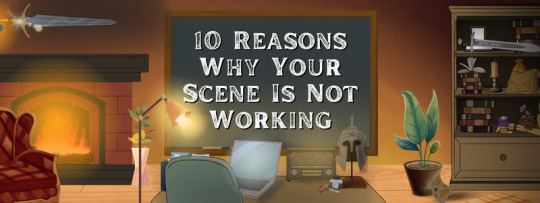
Sometimes I write a scene, and it just does not feel right but I can’t quite put my finger on why. So, since I like lists, I made another one! This one is a list of ways that could possibly fix a scene that is not working for you. I am not saying to try all of these at once, instead read the list, think about your scene, and consider if one or more of these might fix the problematic scene for you.
I hope it helps!

1. Cut Some Parts.
Sometimes when a scene feels wrong, it is because unnecessary moments were added before the conflict of the scene. For example, if there is a fight that will happen and the main characters are having tea before, would the scene be better if you made the tea part shorter? It is possible that the quiet moment might be lasting too long before the action.
2. Add Some Parts.
Just like the last, sometimes there is not enough buildup before going into a scene. For example, if there is a murder about to happen, starting the scene sooner and working to build the right feel (such as an unknown sound or other hints) can help to get readers nervous even before the killer enters. Dropping hints is key for any scene, even a romantic one. If your characters are going to kiss, drop hints to how they are feeling in subtle ways.
3. Check the Mood.
Sometimes, scenes don’t quite hit the mark for what you are going for mood-wise. For example, if you are about to write a scary scene that is meant to be taken seriously, some build up is often needed. If you re-read your scene, and it starts off reading completely care-free and happy mood-wise, you might need to change somethings to get the mood right. If it is supposed to transition from a light-hearted tone to a dark one, maybe work on the area when the transition occurs.
4. Change the Opening Line.
Yes, hooks are important for scene openings too. It entices the reader to keep reading, and can change the whole mood of the scene. For example, saying “There was dried splatters of blood on the floor.” for an opening line instead of “She got home about six at night” really changes the feel.
5. Change the Location.
Some of the most memorial fights in movies and books are memorial because of where they take place. For example, a fight on a dock with waves crashing violently could make a more interesting fight location than an empty street or field, and it adds more danger which makes the scene more tense.
6. Add Conflict.
Conflict does not necessarily mean a physical fight, it could be an argument, or even an inner conflict with oneself. If your scene is not seeming right, it could be that there is not enough of a struggle for the main character. Adding a little conflict can really change the scene.
7. Change the Perspective.
If it still is not working after all of these, perhaps you are using the perspective of the wrong character. Look at the other characters in the scene, and consider what the scene might be like from their eyes. Is it more interesting? If so, you make want to consider switching the perspective of the scene to them.
8. Change the Cast.
Evaluate all the characters in the scene. Is there someone there who’s role could easily be filled by someone else? Would it really change much if they were gone? Or would it raise tension by introducing someone to the scene? Sometimes, changing the cast is all a scene needs.
9. Re-read the previous scene.
Maybe the reason the scene is not working for you is because your subconscious is telling you forgot something in a previous scene. Perhaps the characters emotions are not matching what happened to them in the previous scene, or you forgot an injury. Whatever it is, a re-read can not hurt.
10. End on a Cliff Hanger.
Some writers do this for every scene, while others do this sparingly. Whatever your choice, your troublesome scene might work better if you end it right when it looks like a character has died, or perhaps even when it looked like the enemy might have won.
8 notes
·
View notes
Text
Writers Self-Doubt and Anxiety

I have had a constant struggle with writers doubt and anxiety. I love to write, but the "after "scares me so much that sometimes it is hard to get myself to sit down in front of the keyboard. By “after” I mean when the book is done, and the world gets to see it.
I have often heard the advice “pretend that no one will read what you are writing” but I guess I am not that good at playing pretend, because I can never do that. No matter how hard I try to do that, the little voice reminds me my end goals is, big surprise, to have people read what I have written.
Instead of believing the “no one will read what I am writing” lie, my brain has worked up other lies in the form of excuses.
“I am too tired to write,” my brain will tell me. Or, “I am not in the mood, I will do it tomorrow.”
And so I started putting writing off over and over again.
I am, however, getting better, so while I am still learning ways that help me, I would like to keep updating my process on this in case these lists might help someone else too.

1. Use Outlines
I used to be a pantser, which essentially means you “write by the seat of your pants” or make things up as you go along. There is something exciting about not knowing what your characters will face next. However, I would get about halfway into the story, feel a crash of doubt about where it was going, then tell myself I need to start over. It caused me to stay in an infinite re-writing loop, and there ended up being only one cure; outlines.
I dreaded resorting to that. I assumed it would take the joy out of writing and remove all the writing surprises. As it turns out, all it did was take out one less thing to be anxious about (plot) so I could focus more on everything else.
As an added bonus, you can have your outline reviewed by a trusted friend to help you find plot holes before you even start writing. Fixing these ahead of time and knowing they are fixed really helped boost my confidence before going in and writing the story.

2. Just start.
I tell myself to just start when the excuses are extra loud. They will say anything from “it is too loud in here to write,” to “I don’t have much time, so I might as well not start,” to “I am too stressed to write”, and “I need to do some tasks before writing.”
The funny part is that when I don’t write, I am even more stressed the next day, so using the “I am too stressed to write” excuse was a horrible loop to be in. I would not write because I was stressed, then I would be stressed because I did not write.
The only cure? Just start. Whenever I get the excuses now, I tell myself to just start writing, and I can deal with the rest after.

3. Set a timer.
When I really don’t feel like writing, I set a timer for 1 hour and tell myself I just have to write for that hour, that’s it. The amount of words within that time does not matter, I just have to make it to that hour. This removes the guilt of not meeting wordcount goals, and takes a lot of the pressure off writing. Sometimes, if I feel like it I will write longer than that hour, but those are just bonus words and should not be expected.

4. Utilize To-Do Lists.
This is for whenever you come up with an excuse during your writing time.
Need to clean the bathroom? To-do list.
Remembered something in the story you need to fix? To-do list.
Writing is only time for writing so just put other tasks in the to-do list so you remember to do them after.

5. Watch this video
The title “How Anxiety Can Ruin A Writing Career” is not really fair. It makes it sound like “if you have anxiety, you are doomed as a writer,” but really it is actually about ways he got around his anxiety. I found this video recently, and really suggest giving it a watch.
youtube

6. Join a small writing group
Most people think that a very full and active writing group is best, but that is not always the case. In a big group, you might go unnoticed, so there is no accountability if you don’t write. In a smaller group, however, you get to know each other and cheer each other on.
So, if a writing group has hundreds of members, it might not be best. Instead, try to find a smaller one.
#writing#writers goodies#writing advice#writing tips#Productivity#WritingAnxiety#write#writer#fantasy novel#author#writing fantasy#Youtube#writingbasics
4 notes
·
View notes
Text
Should You Use a Pen Name?🤔
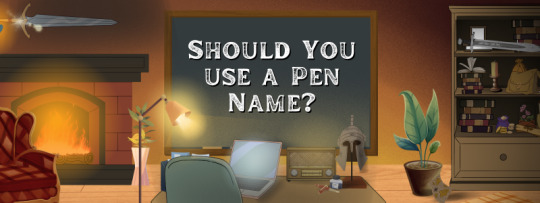
Before diving into the reasons why to consider a pen name, I want to point out that there is absolutely nothing wrong with using your own real name as a writer. Many people dream of seeing their own name printed on the cover of their books, or do not want to bother with having to explain to people in their life why the name on the cover is different from their own. What ever reason you have for wanting to use your real name, you are completely allowed to.
However, if you are curious, here are some common reasons that people decide to use a pen name.
For Privacy
If you have a professional cooperate day job, it might not work for your benefit if people google your name, and the first thing that comes up is a series of silly children’s books. Or perhaps you are a teacher, and you just know that if your students knew what steamy romances you write, you would never hear the end of it in class.
Using a pen name gives you the freedom to follow your writing passions, without having to worry about implications to your daily life.
To Switch Genres
Many writers use pen names to switch genres. For example, Agatha Christie has romance novels under the name “Mary Westmacott,” and Anne Rice (real name Howard Allen Frances O’Brien) has three different pen names for different genres. If you typically write one genre, and suddenly write a new one, someone who recognizes your name at a book shop might pick it up(assuming it to be their usual genre), and be disappointed. This can lead to bad reviews, simply because it ended up in the hands of the wrong genre market.
There are marketing reasons for this, as well. One author I heard on a podcast (6 Figure Authors) talking about using a pen name said that she did it so that her fans could jump over to the new genre she was trying. She feared that well-meaning fans of her fantasy works would leave reviews for her new romance books. You might be wondering why that would be a problem, but the answer is the dreaded Amazon algorithm.
Let’s say you typically read fantasy, and you and a few hundred other fantasy fans review that romance book. Well, the algorithm notices that, and now, instead of the books showing up as recommendations for the intended genre readers, it shows up for fantasy readers. Essentially, that author was worried about losing out on building a new genre fan base (and sales) because of well-meaning fans.
One final reason related to this is for moral reasons. If you typically write children’s fiction, and suddenly write erotica, you will want to use a pen name to protect yourself from the parental outrage that will happen if some of those children fans of yours pick up your newest book.
To Fit the Genre
Dr. Seuss(real name Theodor Seuss Geisel), used a pen name because he wanted to use a name similar to “Mother Goose.” It simply fits the children’s books genre better, and it is also a common reason to switch.
For example, something along the lines of “Elizabeth Potter” just seems to fit with a romance series more than something like “Elysium Crow.” Both are valid, but readers can sometimes judge a lot about a book just because of your name. Is that wrong? Maybe, but I would wager most the time readers who do that do it on a subconscious level, without really knowing why the name made them skip to a different book.
Another reason you may have to switch for a genre is that you have a name that is already famous by someone else, and so now people associate that name with that genre. For example, if your name happens to also be Stephen King and you want to publish cozy and romantic mysteries, it might be in your best interest to take on a pen name.
Making Your Name Easier To Remember
If you have a rather typical name, that can also mean forgettable. Instead, if your name is more unique(Lemony Snicket) it sticks in peoples minds.
For Safety
Sometimes, the choice of using a pen name is made with their own safety in mind. Using a name different than your own can create an extra wall between yourself and people who might want to find you.
It could be that you do not want well-meaning fans knocking at your door every day (assuming you are talented enough to get that popular), but it could also be that you are afraid of stalkers and other creepy types.
Another reason is that some people write fiction that their family or other people in their life might not approve of. For example, imagine telling your “traditional values” ultra-religious family members that you write LGBT+ erotica’s. Yikes.
Because Gender Stereotypes (Sadly) Still Exist
When Mary Shelley(author of Frankenstein) did not use a pen name, she faced things like less pay and cut advances, so it is no wonder that most women authors of those times took on pen names. As an example of this, the sisters Currer(Charlotte, author of Jane Eyre), Emily (Ellis, author of Wuthering Heights), and Acton (Anne, more known for poetry), all picked male names until they had already secured publishers.
Things have drastically improved since then, but not completely. If I tell people I am a writer, it is often assumed I am writing romance. Occasionally, I am even asked if I am trying to be the next Stephanie Meyer. Although romance books are not my personal taste, there is nothing wrong with either romance or Meyer. The real problem is that it proves that gendered stereotypes still exist even today. It is worth noting that I do live in a small farming town with often old-fashioned standards, but a quick look online will show that my problems are not alone. So, if that is the reaction from people looking at my face, what about a name on the spine of a book that is typically considered for women?
Well, some people point out that men are still more likely to get published, and according to studies, men are more likely to not read a book if they know it is written by a woman.
Alternatively, women are more open to reading books by men, but not in the romance genre. Because of that, male romance writers typically pick names that are traditionally associated with women.
Things are changing, and quickly, so hopefully when the kids of today are adults, this will not be a reason to consider a pen name. At the moment, however, it is still a reason many authors consider not using their own name.
To Build A Persona
There is something to be said about building a persona; it creates the feeling that you are as interesting as the characters you create, while also allowing you to show sides of yourself that you might typically hide.
One famous example of this is Lemony Snicket (Daniel Handler), author of A Series of Unfortunate Events. Not only did he use a name that stands out, but he also crafted a complex backstory for this narrator that made people as interested in this “Lemony Snicket” as they were for the main characters in his books.
This might sound quite odd for people, but if you are a naturally shy or reserved person, taking on a persona can help make marketing less daunting.
Freedom
Let’s say you do actually want to publish books under your real name someday, but do not want your “practice” works tarnishing that name as you learn. Well, using a pen name gives you the freedom to write without fear.
Alternatively, some authors (example: O. Henry) have a frowned upon past that people do not want associated with their new career. Similarly, George Orwell(Eric Blair) wrote under a pen name so he could talk about a life of poverty without fear of embarrassing his family.
A pen name can give people a chance at starting over.
For Branding
If you can dive souly into a single genre, then you can make that genre your whole brand. For example, if you write fantasy, you can review fantasy media, share dragon artwork, and even take author pictures with swords. Overtime, people may associate your pen name with that specific genre so much so that you come to mind almost immediately with that genre.
A modern example of this (though to my knowledge, it is not a pen name) is Daniel Greene, who has a Youtube channel dedicated to reporting fantasy news, and now has books in the genre himself. Even before he published, he had cemented himself as being the face of a whole genre to his fans, simply from reporting genre specific news.
On the other side, let’s say Daniel Green suddenly decides he wants to write books on how to grow sunflowers….well, his brand is built around his genre, so it would be easier for him to pick a pen name, and build on that instead. That way, he can post about gardening tips and new gardening science break throughs, and build a brand specific to that.
Other Reasons
For example, Stephen King took up a pen name because his publishers did not want him publishing more than one book a year under his real name.
Others (like Bell Hooks) use a name to honor their ancestors.
2 notes
·
View notes
Text
The Truth about Getting Knocked Out in Movies and Books

In writing, we are allowed a “creative freedom” where not everything we write has to be realistic to how it actually would happen in real life. We can have a hero walk away with an explosion directly behind him, we can have him somehow never have to reload his gun, and we can have him be hit by a car and roll over it, and just keep running. They are common action movie scenes that many viewers don’t even blink at, but there is another one that is missing here, and it is one that can be found in almost every genre ever:
The hero getting knocked out.
Most commonly, the hero is hit over the head with something, and wakes up hours later somewhere else. In action movies, the hero awakes as if he were simply sleeping, and is able to use that (somehow uninjured) brain to think up the perfect escape.
The “knock over the head” is seen as a quick way to capture even the toughest of fighters, so often so fans can worry for them and wonder how the hero will escape.
In real life, he would likely be dead, or in extreme need of medical care. If you are knocked out for under a minute, a checkup is recommended. Over a minute, and you are supposed to be seen at an emergency care hospital for dangers such as internal bleeding of the brain.
That is just a single minute, and many fiction heroes are out for hours.
Even being if knocked out that long somehow does not kill you, you are still going to have some effects. Concussions are not fun, and can cause several symptoms; including light sensitivity, and more.
Concussion Symptoms
🔹Headache or “pressure” in head.
🔹Nausea or vomiting.
🔹Balance problems or dizziness, or double or blurry vision.
🔹Bothered by light or noise.
🔹Feeling sluggish, hazy, foggy, or groggy.
🔹Confusion, or concentration or memory problems.
🔹Just not “feeling right,” or “feeling down”.
csc.gov
So what can you do? You could still have the main character hit over the head, and disoriented. Then, they can be tied up and blindfolded and still brought to where you need them to be. From then on, the hero trying to fight despite injuries raises the risks for the hero, making it more thrilling for the reader.
Now, before you say “what about chloroform?” Sadly, friend, that is also partially a movie myth.
Scientists estimate that it would probably take around 5 minutes for an adult person to become unconscious from breathing though a cloth with chloroform on it.
technology.org
In movies, the hero is snuck up on from behind, and a white cloth is pressed over their nose and mouth. Within seconds, they drop, and are out for however long the bad guy needs.
In real life, with how long it can take chloroform to hit, you would have o overpower the hero first(which is an option you could go with). In that fight, unless the baddie is wearing a mask, they are in as much danger of breathing the chloroform as the hero.
So, you have two options here; the first is to keep searching for the perfect way to have your character be temporarily subdued, or you could go with the second option: just give yourself the creative freedom to write what you want. Both are valid paths, so no matter which you take, I hope you have a great time writing.
2 notes
·
View notes
Text
The Hero’s Journey: A Plot Recipe Used by Star Wars, Harry Potter, Mulan, and way more.
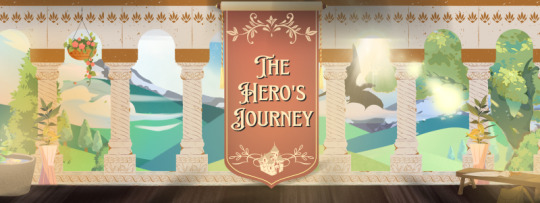
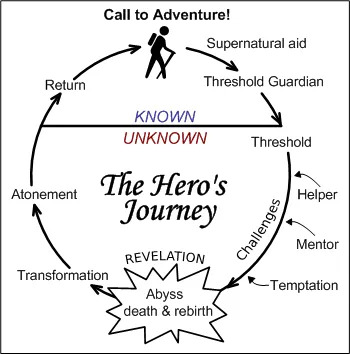
Simplified Journey Illustration by Reg Harris
Have you heard of the plot structure called The Hero’s Journey? Even if you haven’t, you certainly do know it, as it is one of the oldest (and very used) plot recipes of all time.
From Star Wars, to The Lion King, to Lord of the Rings, and even Shrek, they all follow the same plot beats.
The beats may be in slightly different order(and there are many different names for these), but the basics are simply that the hero goes on an adventure, is victorious, and comes home changed.
This formula tends to be used in most popular movies, and while some critics say that is a bad thing, it does not change the fact that the readers or watchers of those stories tend to love the structure.
1. The Call to Adventure.
These stories typically start with the character living a normal life, often while unknowing that something is missing in their life. Then something uproots that normal life and tosses the main character on a quest. This is often a message, words from an elder, or a sudden life-changing moment.
For Frodo, it was when he was told by Gandalf that the ring had to leave the Shire (Lord of the Rings), for Luke, it was when he found the message asking for help from Princess Leia (Star Wars), and for Shrek, it was when he was faced with the problem of his home being overrun by refugees, and he sets off on a Journey to be rid of them.
The hero is often very reluctant to leave their normal life(or simply is in denial), and may downright refuse to go.
2. The Mentor
The hero needs guidance on their journey, and in fairy tails, it is often a wise-woman who tells the hero advice or items that will save them with what tasks they have ahead. Without them, the hero would never accomplish their goals.
For Mulan, this was Mushu(Disney’s animated Mulan). For Simba, this was Timon and Pumbaa(The Lion King). for Luke, it was Obi-Wan Kenobi(Star Wars).
3. The First Threshold
This is a moment of big change for the main character where they embrace the journey(though it may be reluctantly).
The hero has what they need now, and suddenly they are facing a big problem. No matter what the problem is, the result is that there is no going back for the Hero, and they have to finish the quest. That is why some writers call this “The First Doorway of No Return.”
4. Challenges
The character finds themselves somewhere very different from their home. They find allies, perhaps meet a love interest, and face a series of trials.
In fairy tails and old stories, there are often three small trials. These trials often test the resolve of the hero, but he ultimately makes it through. The hero will likely also be tempted by something that will make them want to give up their journey, but they do not give in.
All the above show the reader that the character has resolve, but also skills that are needed.
5. The Darkest Moments
The hero faces something, and is ruined by it. Whatever happens, they have hit rock bottom.
Often, this is when the mentor character dies, when the main character themselves die, they lose something important to them, or when something causes them to break down. They are either dead in body or spirit.
After it seems like all hope is lost, the hero faces a rebirth (sometimes literally) and again continues on the journey. They sometimes find or are given a MacGuffin that helps them later on.
6. The Win
They are up against the impossible obstacle they face (sometimes also in the form of 3 trials) and often sacrifice themselves in order to win.
They beat the obstacle, but the journey as a whole has changed them so drastically, that the person at the start of the quest may seem like a different person all together.
They also have something the didn’t before (sometimes a MacGuffin or love interest), and face a moment where they correct a mistake they made in the past.
7. The Return.
The hero returns home(or to the place they now consider their home). Here, the hero often grants a boon to their people, or the people who stood in the hero’s way at the start face their justice.
The character may have been changed for the better or the worst, but the quest is officially finished.
That’s it! As you can probably understand now, yes, it is a recipe, but what ingredients people use are different to every writer. While one person might use a best friend as the mentor, another person might use the villain. While one person might have the “trials” be physical fights, for another person it could just be school tests. The point is that the structure is close to the same, while the ingredients are unique to the writer.
For example, yes, while both Luke and Frodo do follow the Heroes Journey, one went for the lush green Shire, and the other went for the sandy Tatooine as the starting point. While one kept the wise-old mentor dead, the other brought him back reborn. While both picked a bittersweet yet hopeful ending, one sad mix was due to the loss of someone, while the other sad mix was because of the mental scars the journey caused for Frodo.
That is also not to say that you have to follow this formula; in fact, many don’t. I just think it is important to know the common plot formulas, so that you can begin to recognize them in the media around you. I hope that in doing so myself, it can help me narrow down exactly why I love the stories I do, while also taking a moment to appreciate the unique twists the writers have used.
If you are curious about how the stories I mentioned used the formula, here are some links from other bloggers:
Mulan
Shrek
The Lord of the Rings
The Lion King
Harry Potter
Jurassic Park
The Goonies
The Matrix
Avatar: The Last Airbender
#WritingBasics#writingtips#writing tips#writing advice#write#writer#author#novel#book#writing#writingtip#creative writing
4 notes
·
View notes
Text
In Defense of Direct Inspiration
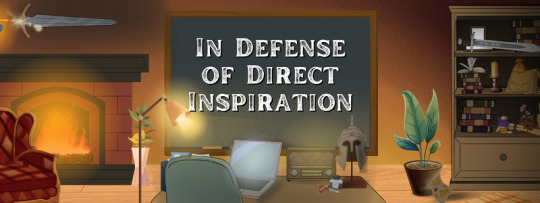
There is a belief that writers come up with ideas out of their imagination as simply as you pick apples from a tree, but that is not always the case. Sometimes writers hear a story, and it stays with them so long that they are inspired by it. Put simply: they take a base story, and build off it.
Now you might be thinking “well that is cheating!” and if that is the case, then Disney is the biggest cheater of all. Disney really started to explode in popularity when they took fairytales, like Cinderella and Snow White, and gave them life in animated form. When that worked for them, they moved on to folk tales and books.
For example, in the book The Littlest Mermaid by Hans Cristian Anderson, the base story is quite similar to the Disney The Little Mermaid, but they did some tweaking (like by not having her die at the end), added some Disney magic, and boom, a hit. Even Mulan is based off a folk tale.
My point is that what Disney is great at is taking stories, like they did with the fairy tale The Snow Queen, and building it into a money maker(Frozen). They do not always spend time trying to come up with a basic plot, instead they take an old story, take what they need, and reimagine the rest.
Doing this not only saves time and money, but it can be an interesting challenge for your imagination. If you retell Little Red Riding Hood the way it has always been told, people will not want to read it because they will feel like they have read it before. However, if Little Red Riding Hood is a hunter and the wolf is a werewolf, it changes it drastically. It is still the same story in basics, but it is the twists you weave in that draw your readers to keep reading.
If Disney is not the example you want, the same is done for almost every popular book there is. Harry Potter (don’t kill me for saying this, Potter fans) is basically a mix of The Wizard of Earthsea, The Worst Witch, and mythological creatures from our world. Game of Thrones is almost the the exact “plotline” to the real lifeWar of the Roses.
No one argues that these authors are cheating because they made the stories their own and wrote them in a way that spoke to people.
For a final example: Star Wars (the originals) follow “The Hero’s Journey” plotline beat-for-beat, but the addition of space, aliens, and the inspiration from old samurai films, gave us the Star Wars we know. For those who do not know, the hero’s journey is the most common template for stories that involve a hero going on an adventure, does the adventuring, and comes home a changed person.
So, if you want to write a reimagined fairy or folk tale or even a time in history, do not feel like you are cheating. There is still plenty of work to do, and writing a reimagined work does not make you less of a writer.
3 notes
·
View notes
Text
"50 Productivity Tips to Boost Your Brainpower As A Writer[infographic]"

From here
#writing#write#writer#author#novelist#writing advice#writingtips#WritingBasics#boostingcreativity#productivity
1 note
·
View note